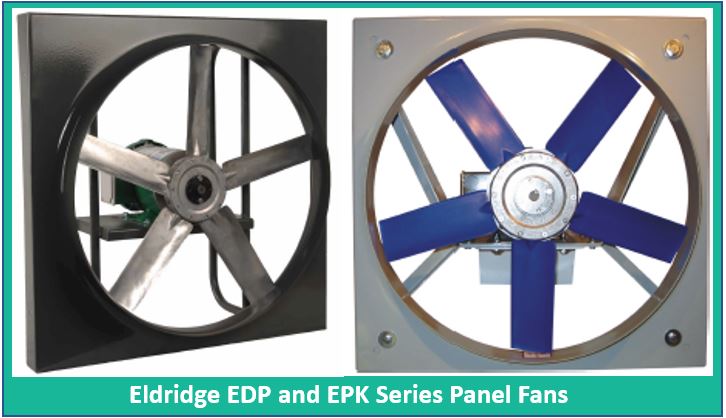A common question from customers is how to choose a suitable ventilation system for their facility. At Eldridge, when designing an industrial ventilation system, our focus is on achieving the primary objective of expelling hot or contaminated air from the facility while supplying fresh outside air. The most suitable system for any facility to meet that objective is determined by numerous factors. However, the two primary ones are the customer’s activities and the layout of the building. In this blog, I’ll discuss the four approaches to be considered when choosing the suitable ventilation system for your facility and how they address the two primary factors.
Gravity Supply and Powered Exhaust
This approach utilizes exhaust fans to draw out air and relies on natural airflow or gravity to bring in fresh air. This is achieved by creating a negative pressure inside the building when the fans are in operation. Typically, the exhaust fans are positioned on the roof or high on the walls. The building’s existing openings, like people or vehicle doors, are utilized as air supply sources. However, if these openings are insufficient in providing the necessary amount of air without causing a hazardous level of negative pressure, louvers can be installed along the building’s perimeter.
A powered exhaust ventilation system that utilizes existing openings in a building for supply air is the most affordable and widely used option. This type of system is particularly effective when manufacturing areas are connected to conditioned offices. The negative pressure created by the ventilation system prevents heat and pollutants from entering the offices.
Powered Supply and Gravity Exhaust
This approach system utilizes floor-level fans for air supply. Additionally, ridge vents, hoods, or louvers situated on the roof or high on the walls enable natural airflow or gravity to exhaust the air. The positive pressure generated by the supply fans helps push the exhaust air out of the building. To ensure effective exhaust of hot air at the top of the building, it is recommended to keep the doors for people or vehicles closed. If not, open doors can cause short-circuiting of the airflow.
The gravity exhaust and powered supply system is most effective in situations where a clean air supply is necessary and contamination must be prevented, such as in food processing facilities. These facilities commonly utilize this type of system, which features filters on the supply fans.
Powered Supply and Powered Exhaust
This type of ventilation system is capable of creating either a negative or positive pressure within the building. Depending on the desired outcome, the exhaust and supply fan airflows can be adjusted to achieve the desired pressure.
A powered exhaust and supply system is the most costly option for ventilation systems. However, it offers the greatest level of control in determining where the air enters and exits a structure. This is particularly advantageous for buildings that require a high rate of air exchange. The system can be designed to prevent dangerous levels of pressure when the exhaust and supply fans are coordinated.
Gravity Supply and Gravity Exhaust
This type of ventilation system relies on the combination of wind and the building’s height to generate a natural airflow. As hot air tends to rise, a tall building can function as a chimney. That allows hot air to escape through the openings on the roof. This creates a suction effect that draws in fresh air through the lower openings in the building. This process is known as the stack effect. Placing the supply openings on the wind-facing side of the building can greatly amplify this stack effect.
Despite being the most cost-effective ventilation system, its airflow capacity and reliability are the weakest. In some areas, prevailing winds may be unreliable or wind speeds may be too low. As a result, the rate of air exchange within the building may not be sufficient to ensure satisfactory cooling.
Summary
No matter if your project is a new construction or a renovation, we hope that these descriptions of the four types of industrial ventilation systems will provide clarity on which system is suitable for your facility. The Eldridge team of ventilation specialists can assist in determining which system to choose and will ensure that the ventilation system is tailored to meet your requirements. It is our mission to help customers create successful working environments for their employees.
